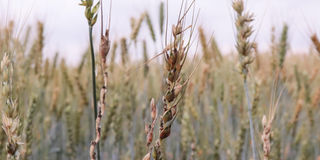Nakuru farmers at risk of losing 19,000ha of wheat to red-billed quelea birds

Some of the wheat heads affected by red -billed birds at a farm in Rongai on July 29, 2024.
Wheat heads in Rongai and Njoro sub-counties are now turning yellow, indicating to farmers that harvest season is just around the corner.
Above them are small grey-yellowish birds moving in flocks. It is hard to imagine that a flock of these birds flying over your farm could be a menace.
19,000 hectares of wheat in Nakuru County are said to be at risk of invasion from the quelea quelea/ red-billed bird.
A confirmatory survey by officials from the National and County governments on two farms (500 and 60 acres respectively) has revealed the extent of the problem.
The birds, according to an expert, are noted to roost in the millions and consume up to 10 grams of wheat and other small-seeded crops like sorghum, and rice among others, per day.
Ishmael Muganda, a Crop Protection Officer from the Plant Protection and Food Safety Directorate, notes that they're estimating a population of more than three million birds, that threaten to destroy about 30,000 kgs of the county's food production daily.

Ishmael Muganda, a Crop Protection Officer from the Plant Protection and Food Safety Directorate during an interview on July 29, 2024.
Mtaa Wangu accompanied the experts who determined some of two roosting grounds set up by the birds in Menengai West ward in Rongai sub-county, close to residential areas where the expert notes they may need to resolve to safer causes of action.
"From our findings, the roosting grounds are in residential areas, which has prompted us to establish and resolve to a safer cause of action," says Muganda.
To this effect, he notes that drone spraying and county spray service providers donned in protective gear will be used for the control exercise after the community sensitization exercise on Tuesday (today).
"We are focused on reducing the population of the birds by 95 percent using chemicals, which are proved to be a bit environmentally friendly. Once the population is reduced they'll be unable to move as a colony reducing the damage they cause," he says.
The migratory birds that move in colonies have distinct breeding and feeding seasons.
"When the feeding season arrives, they migrate in search of food. After combating 95 percent of the birds, we expect the other five percent to live in solitary, unable to cause significant harm," explains the expert.
In Kenya, a consistent pattern of invasion has been observed, typically affecting 11 counties.
However, Muganda cautions that when weather conditions become favourable, these birds can quickly congregate, breed, and multiply. It's during these population booms that they cause the most damage to crops.


